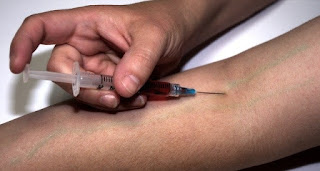parenteral preparation
The parenteral preparation or injectables are the sterile solution or suspensions, of drugs in aqueous or oily solvent forgiven directly into the body, parenteral preparation is another route of drug administration into the body. Since they are introduced into the internal body, they must be sterile and free from all types of living microorganisms and microbial products such as toxins, pyrogens, etc |
| Pixabay License |
The administration of drugs or medicines into the body other than the mouth is called the parenteral route.
Parenteral preparations are administered directly into the systemic circulation in the human body.
which of the following is not an example of parenteral preparation, Injectable should be isotonic with body fluids.
isotonic is a solution having the same osmotic pressure as some other solution, especially a body fluid.
Parental preparation must be introduced through the same route for which they are intended for example -if an oily suspension for intramuscular injection is introduced by intravenous injection may be fatal. similarly, potent drugs meant for administration through intramuscular injection may lead to even death if given by intravenous injection.
Examples of parenteral preparation
- 5% sodium chloride injection
- 5% dextrose injection
- 10% dextrose injection
- 5% ringer lactated injection
- dextrose and normal saline injection
- mannitol solution
- Diclofenac sodium injection
- dexamethasone injection
- metronidazole injection
- ciprofloxacin injection
- gentamycin injection
- amikacin injection
Routes of administration of parental products
Routes of administration of parenteral products are as follows.
These injections are given in between the dermis and epidermis. Absorption by this route is slow therefore usually small volume from 0.1 to 0.5 ml is injected. Mainly used for the sensitivity of the injectable and diagnosis purposes.
these injections are given in the subcutaneous tissue under the skin of the upper. A volume of 1 ml or less can be injected by this route .this is a more popular route because it is convenient for the patient and doctor.
These injections are given to the muscular tissue. The muscle of the shoulder, thigh, or buttock area is usually selected .generally volume up to 2 ml to 5 ml is administrated by this route at one site.
These injections are given into the vein, therefore drugs directly reach the bloodstream. A large volume of solution ranging from 1 ml to 500ml or even more, can be injected by this route.
- Intracutaneous or intradermal injection,
- Subcutaneous or hypodermic injection,
- Intramuscular injection,
- Intravenous,
- Intraarterial injection,
- Intracardiac injection,
- Intrathecal injection,
- Intracisternal,
- Intracisternal,
- Peridural injection
- Intraarticular injection
Intracutaneous or intradermal injection
These injections are given in between the dermis and epidermis. Absorption by this route is slow therefore usually small volume from 0.1 to 0.5 ml is injected. Mainly used for the sensitivity of the injectable and diagnosis purposes.
Subcutaneous or hypodermic injection
these injections are given in the subcutaneous tissue under the skin of the upper. A volume of 1 ml or less can be injected by this route .this is a more popular route because it is convenient for the patient and doctor.
Intramuscular injection
These injections are given to the muscular tissue. The muscle of the shoulder, thigh, or buttock area is usually selected .generally volume up to 2 ml to 5 ml is administrated by this route at one site.
Intravenous
These injections are given into the vein, therefore drugs directly reach the bloodstream. A large volume of solution ranging from 1 ml to 500ml or even more, can be injected by this route.
Oily injection and suspension cannot be injected by this route.
These injections are given directly into the artery. when an immediate effect in a peripheral area is required. They are occasionally used.
Intraarterial injection
These injections are given directly into the artery. when an immediate effect in a peripheral area is required. They are occasionally used.
Less commonly used routes
Intracardiac injection, this intracardiac injection is given directly into the heart muscle or ventricle and is used in emergencies.
The intrathecal injection is given into the subarachnoid space surrounding the spinal cord. This route is used to deliver spinal anesthesia.
Intrauterine is placed between the first and second cervical vertebrae. This route is mainly used to drain cerebrospinal fluid for diagnostic purposes.
Peridural injections are given between the dura mater and the internal aspects of the vertebrae. This route is used to deliver spinal anesthesia in special cases.
Intraarticular injections are given in a liquid that lubricates the joints.
Intracerebral Injection is given into the cerebrum
The essential properties of a parenteral product are
- Should follow parental product quality.
- It should be free from live microorganisms and microorganism products.
- It should be free of pyrogens.
- Must be free from foreign particles.
- Must be free from chemical contaminants
- Must be isotonic with body fluids
- Multi-dose injections must contain preservatives.
- should not be affected by the container

.png)


0 Comments
please do not send a spasm massage.